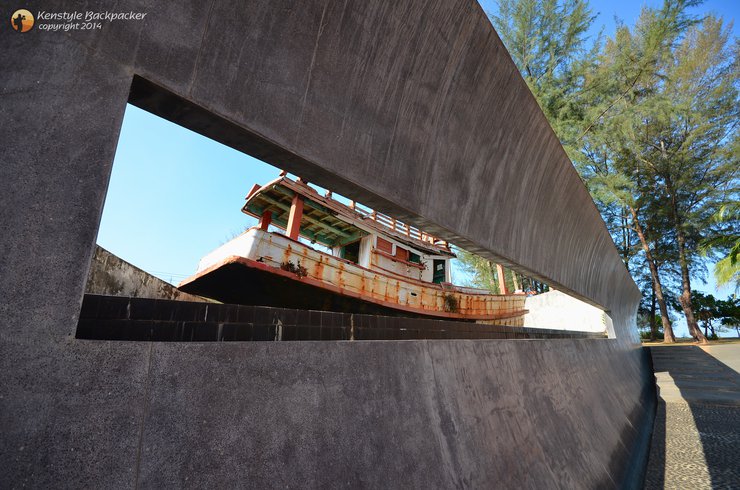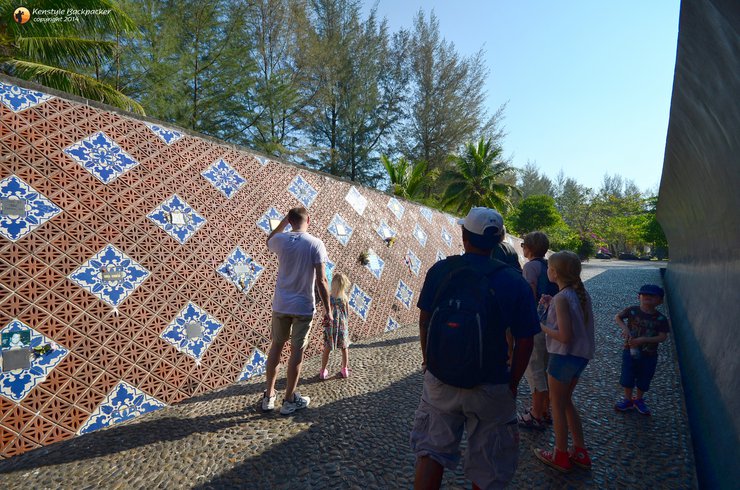...During the course of our lives, sometimes the things we have long sought after never materialize, while other things enter our lives unexpectedly. Looking back two years, the political situation in the country had reached a breaking point, and my workplace became a battleground. As a result, my workplace had to temporarily close, and some of the employees were sent to work in various southern provinces to reduce the company's expenses and wait for the situation to improve. I was one of them. Although I had to leave my family, it was better than being unemployed. I only received a few days' notice to report to my new workplace, and the province I was assigned to was one that I had fallen in love with and wanted to visit again after visiting it 20 years ago. That province was **"Phang Nga."**
"Khao Lak": My Temporary Abode
During my free time each week, I would explore the various tourist attractions in the area. The place I'm going to review this time is an island I had never heard of before. I only came across it after I had already visited all the famous islands in the area. Looking for a new place to explore, I stumbled upon an island with a peculiar name: "Khao Khao Island."
Let me take you on a journey to discover what this island has to offer.
From Khao Lak, I rode my motorbike north on Phetkasem Road (Highway 4) towards Takua Pa District. The journey took about an hour and a half, covering a distance of approximately 40 kilometers. Turning left near Bang Muang School, I continued straight along the road.
Before reaching the island, I stopped by the Tsunami Memorial Park in Ban Nam Khem. Located along the entrance road to the village, this park features a tsunami shelter building. Regular tsunami evacuation drills are conducted here.


I turned the car into the parking lot in front of the memorial. The first feeling after parking the car was that it was strangely quiet and deserted, even though it was the middle of the day. I walked straight to the memorial, which was designed as a wall resembling a giant wave. There was a fishing boat that had been washed ashore on the top of the wall. Behind the wall, there was a walkway parallel to the wall where the boat was located. The other side of the wall was covered with ceramic tiles with the names of those who died in the incident. Some of the deceased had wreaths laid in front of them, showing their condolences. Although a long time has passed since the loss, I believe that no one has forgotten the incident, especially those who lost loved ones.





Behind the monument, a large Buddha statue stands facing the beach of Ban Nam Khem, serving as a source of strength and encouragement for the villagers. Additionally, there are shrines dedicated to Prince Chumphon and the Sea Serpent Father, which are also revered by the locals.



The serene beach of Ban Nam Khem is rarely visited, with only an occasional tourist boat passing by on its way to explore the nearby islands. Across the water lies the tranquil island of Ko Khao, a place forever etched in the memories of many as the epicenter of the devastating tsunami that struck on December 26, 2004. The island, spanning 27 kilometers from tip to tail, is mostly flat, making it difficult to discern as an island from afar. Its shores are lined with pine forests, and a solitary resort stands isolated, seemingly deserted. Once, the beach was dotted with fishermen's houses, but after the tsunami, residents relocated further inland or sought livelihoods on the mainland.





I rode my motorbike from the monument to the Ban Nam Khem ferry pier. Along the way, I saw a strange-looking building with no windows, only small holes. I later learned that this building was built to provide a nesting place for swiftlets. The nests are harvested and sold for a high price, with a single kilogram fetching tens of thousands of baht. High-quality nests can even sell for half a million baht. No wonder they can afford to build such a building for the swiftlets to nest in.


To reach Ban Nam Kem Pier, you can take a motorbike across the river for 20 baht per bike. Alternatively, cars can take a ferry for 150 baht per car. The journey from the mainland to the island is short, taking only about 10 minutes.




I crossed the river to the first point of the island, which is Ban Pak Khao. This point has a sign showing the distance to the various villages on the island, of which there are a total of 5 villages, as well as a sign showing the various resorts, of which there are only a few on the island. Ban Pak Khao is the main point of the island, where all the shops, restaurants and motorbike rental shops are located.



The island's roads are well-paved. I drove through the scorching sun with no particular destination, simply following the coastline. If there was a path leading to the beach, I would turn in to investigate. The paths were visible as tracks through the fiery red grassland, a result of the arid climate in this region during the summer months. Scattered across the island were traces of wildfires.



The tranquil emerald sea stretches before me, its surface undisturbed by a single ripple. The soft, brown sand contrasts sharply with the vibrant blue sky, creating a mesmerizing gradient that draws the eye into the depths of nature's embrace. Scattered remnants of pine trees, victims of the devastating tsunami, stand as silent sentinels. Some of their sturdy trunks have been salvaged for practical use, leaving behind only decaying roots that slowly succumb to the passage of time. Others resemble otherworldly creatures, their twisted forms defying earthly logic. To my left, the resort where I stand overlooks the brackish water, while to my right, a dense pine forest stretches as far as the eye can see. In this vast expanse, human presence is scarce, making it a sanctuary for the wonders of nature.




I exited back onto the main road of the island and headed west, passing a couple of resorts. I spotted a sign by the road for a place called Sun Beach, so I decided to check it out. The interior was a beach with small canvas beds under wooden pergolas that seemed to be made from natural materials, emphasizing simplicity and harmony. However, there was no sign of any people.


Note:


I walked out onto the beach. Everything seemed calm, as if time had stopped. Looking to the left, I saw foreign tourists napping in the shade of a pavilion during the midday sun. The heat of the air caused a wildfire that could be seen far and wide. On the left, I saw a white sandbank emerging from the sea, stretching as far as the eye could see. This was "Koh Pha," a popular diving spot. In the past, the island was covered with lush trees, but after the tsunami, only two ornamental trees remained.





After leaving Sun Beach, I continued to explore the island by car, stopping at any interesting spots I came across. Most of the beaches I visited were deserted and overgrown, as they were not tourist destinations. The only places where tourists would swim were likely in front of the resorts where they were staying.





Continuing my drive, I stumbled upon another restaurant called "Sea Sun Set," situated at the headland. Drawn by the stunning view, I decided to stop for a bite to eat. The restaurant's simple design seamlessly blended with the natural surroundings. Notably, the island lacked any high-rise buildings, and most restaurants prioritized natural materials. The restaurant's highlight was the rustic beachside pavilion, reminiscent of a castaway's makeshift shelter, evoking the atmosphere of the film "Cast Away."






Continuing the journey, I felt a growing sense of isolation as I ventured deeper into the island's interior. The roads became increasingly deserted, with only occasional glimpses of other vehicles. I decided to explore the opposite side of the island, which was covered in dense forest. As I drove along, I was surrounded by vast fields of grass. Near the end of the road, I spotted a pond with a lone house nearby. However, I hesitated to approach, fearing an unwelcome reception. The island is known for its kayaking and hiking trails leading to the Ton Thong waterfall. However, these activities are only available during the rainy season, which was not the case during my visit.






On the way back, which retraced the same route as the way there, there was a beach that we passed by. On the way back, we decided to stop by and take a look. It was called Ha Pla Beach. Actually, this beach area used to be a fishing community, but after the tsunami, it became deserted. A beach bar-style restaurant has opened to serve foreign tourists. Most of the tourists on the island are Scandinavians escaping the hustle and bustle of Phuket and staying for long periods, sometimes weeks, in the area stretching from Khao Lak to Ko Khao. This restaurant is located in a pine grove, making it more shady than other restaurants, and there were many tourists sunbathing.






The beach in this area is noticeably cleaner than others, with fine sand and no debris such as leaves or branches. This suggests regular maintenance and cleaning efforts.






After leaving "Ha Pla Beach", it was time to say goodbye. I didn't stay to take pictures of the sunset because I was afraid I wouldn't make it back to shore in time, and I wasn't prepared to stay overnight. I arrived at the pier near Ban Pak Ko around 4 pm. While waiting for the boat, I sat and looked at the view around the island. Amidst the beauty we saw, there were traces of tears from those who had lost loved ones in the disaster. Although this island has gone through a terrible event, with thousands of people dying here, everything must go on. The remaining debris serves as a reminder of the terrifying power of nature that humans can never conquer.







Ko Khao: A Tranquil Island Escape in Phang Nga
Ko Khao, a hidden gem in Phang Nga province, offers a serene escape from the bustling crowds of nearby islands. Its flat terrain, adorned with lush pine and coconut groves, boasts pristine white sand beaches stretching for kilometers. The calm waters invite visitors to swim and soak in the tranquility.
Accommodation options range from resorts and bungalows to restaurants, catering to the needs of diverse travelers. Reaching Ko Khao is a breeze, with boats departing from Ban Nam Khem Pier in Tambon Bang Muang, Takua Pa district. The journey takes approximately 15 minutes, with chartered boats and ferries readily available.
Beyond its tranquil shores, Ko Khao and its surrounding areas offer captivating attractions, including:
The Ancient City of Ban Tung Tuek
Location: Ban Tung Tuek, Moo 3, Koh Kaew District, Takua Pa District, Phang Nga Province, Thailand.
Description: Situated between the mouth of Khlong Muang Thong and Khlong Tung Tuek, the ancient city of Ban Tung Tuek lies at the mouth of the Takua Pa River. The area is characterized by its sandy clay terrain, hence the local name "Tung Tuek," which translates to "field of buildings." This moniker stems from the numerous ancient structures resembling buildings or temples scattered across the several-rai sandy clearing amidst the dense forest. These structures are accompanied by abundant fragments of religious artifacts and symbols associated with Brahmanism. Additionally, the site yields numerous shards of Chinese ceramic tiles, bowls, and plates, along with fragments of earthenware vessels and other materials.
Significance: Archaeological evidence suggests that Ban Tung Tuek likely served as an ancient port city frequented by Indian, Arab, and Mon traders. The presence of Brahmanical artifacts and the strategic location at the mouth of a river support this interpretation.
**Koh Pha** is a small island in the fourth group of Koh Khao District, located approximately 10 kilometers from the coast. It boasts crystal-clear turquoise waters, abundant coral reefs, and pristine white sand beaches, offering a tranquil haven for relaxation.
Ton Thong Waterfall: A Hidden Gem in Koh Khao
The Ton Thong Waterfall, a breathtaking natural wonder, serves as the sole freshwater source for the inhabitants of Koh Khao. This hidden gem, nestled within the heart of the Khlong Ton Community Forest, offers a thrilling and adventurous journey for visitors seeking its beauty.
The cascading waters of Ton Thong create a refreshing mist, rewarding those who brave the challenging trek to reach it. The community diligently protects this natural treasure, ensuring its preservation as a vital source of life for the island.
However, access to Ton Thong is limited to the months between October and February, making it a seasonal spectacle worth experiencing.
Directions
From Phetkasem Road No. 4, a beachside road from Khao Lak to Takua Pa, turn left at Ban Nam Khem. Continue straight past Ban Bang Muang School to Moo 2, Ban Nam Khem, Tambon Bang Muang. The road is concrete.
To reach the pier in Ban Nam Khem, take a hired boat (long-tail boat, 7:00 AM - 8:00 PM, motorcycle on board 20 baht). Outside of these hours, a private boat can be chartered at an additional cost. Alternatively, a car ferry (7:30 AM - 4:00 PM, car 150 baht) can be taken to the pier in Ban Pak Ko, Moo 3, Tambon Ko Khao. From there, asphalt roads lead to other villages.
- Thank you to all my friends who have come to watch, like and share. It really means a lot to me.
- For information exchange or inquiries about travel, please visit our Fanpage: Studdoy
- For older articles, please visit All Travel Trips here.
Is there anything else I can help you with?
Is there anything else I can help you with?
สตั๊ดดอย ร้อยเรื่องราว
Friday, October 4, 2024 3:02 PM















